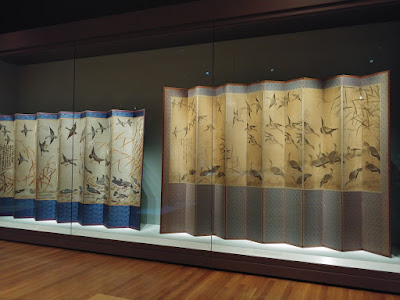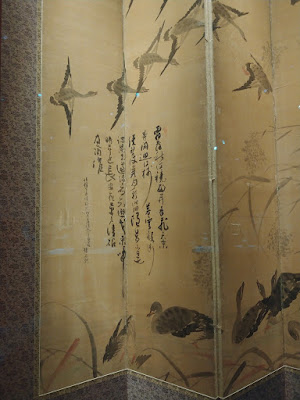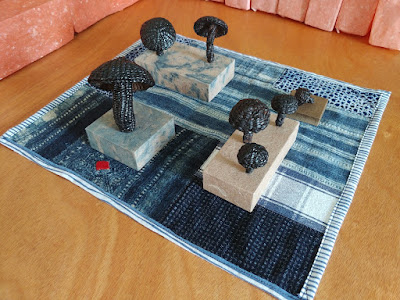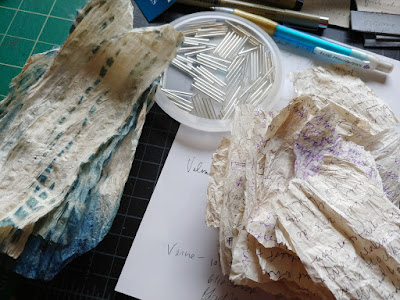These woods were my favorite parts of the trail but most of the hike was through more boring brush. This weekend I will attempt more scenic areas with a friend, though I know a lot of the leaves have already fallen.
I also realized that I will need new socks for my boots that like to pull them down.
Sopheap Pich's work is immediately recognizable, even from a distance. After listening a bit to Mind Your Practice (Beth Pickens' mini podcast for artists), I knew I needed to get back to the museum to catch the rest of the Korean embroidery show before it closed yesterday. Instead of going directly into the Korean section, I came up the escalator and went into the Southeast Asian gallery and was glad to find these 2015 Seed Pods amidst antiquities.
These are Korean rank badges that visually indicate the rank/status of particular people, in this case, a scholar-official (cranes signified "scholarly integrity and elegance" as per the museum label). I loved that the actual badge was on display right next to ...
... a depiction of the badge on an actual person. This painting by Chae Yongshin (1848–1941) is Portrait of a Young Officer from 1921. There is a crane badge!
Though my eye went not only to the tail of the fur and these shoes, but to the woven mat underneath.
These screens side by side were also stunning, as they show a painted and embroidered version of Geese and Reeds by Yang Gi-hun (1843–1919?), a master painter from Pyongyang, who "had no rival in painting bird-and-flower themes." You can't tell from here but the left one is embroidered, and apparently these very fancy screens were worth as much as a house in downtown Seoul at the start of the 20th century.
Painted version
Embroidered version. Mostly I was sad that the show looks like it is in the textile gallery, but then there is much more in the Korean gallery (the Japanese gallery sits between those two). I fear that people missed this section of the show. Regardless, the curator did a fabulous job—congrats to Sooa!
At home, the actual installation bit for the bricks stymied me so much that I went REALLY small and started to sew underwear.
Then I focused on constructing little box stands for these mushrooms that a conservator so kindly lacquered for me. It's so hard to find people who can do this in the US, so this was a huge achievement. I have also been sewing like a maniac, completely unrelated to anything I need to be doing, and the patchwork underneath the stands is one result of productive procrastination.
I also mixed up some persimmon powder to coat four more mushrooms and went to Bill's shop to trim a couple mahogany stands to size. I've been obsessing for almost a week over art that will occupy one pedestal when I really need to be building an installation. But the rapid ascent of a terrifyingly backwards robototron judge—against the will of most of this country—sidelined my ability to do much besides prepping mushrooms. While scrubbing my bathtub, I listened to Beth Pickens estimate our current capacity to work, which is 40% of pre-pandemic times. That sounded extremely fair. Now that I have a number for this lowered capacity, I can embrace that it's my best for now and be grateful for simply getting out of bed in the morning.
At home, the actual installation bit for the bricks stymied me so much that I went REALLY small and started to sew underwear.
Then I focused on constructing little box stands for these mushrooms that a conservator so kindly lacquered for me. It's so hard to find people who can do this in the US, so this was a huge achievement. I have also been sewing like a maniac, completely unrelated to anything I need to be doing, and the patchwork underneath the stands is one result of productive procrastination.
I also mixed up some persimmon powder to coat four more mushrooms and went to Bill's shop to trim a couple mahogany stands to size. I've been obsessing for almost a week over art that will occupy one pedestal when I really need to be building an installation. But the rapid ascent of a terrifyingly backwards robototron judge—against the will of most of this country—sidelined my ability to do much besides prepping mushrooms. While scrubbing my bathtub, I listened to Beth Pickens estimate our current capacity to work, which is 40% of pre-pandemic times. That sounded extremely fair. Now that I have a number for this lowered capacity, I can embrace that it's my best for now and be grateful for simply getting out of bed in the morning.

































